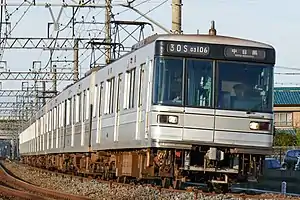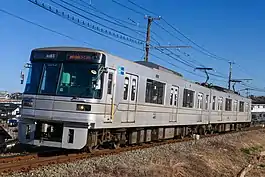| Tokyo Metro 03 series | |
|---|---|
 An 03 series train on the Tobu Nikko Line in December 2018 | |
| In service | 1988–February 2020 |
| Manufacturer | Kawasaki Heavy Industries, Nippon Sharyo, Kinki Sharyo, Tokyu Car Corporation |
| Replaced | TRTA 3000 series (Tokyo Metro) Nagaden 3500/3600 series (Nagaden) Kumaden 6000 series (Kumaden) |
| Constructed | 1988–1994, 2001 |
| Entered service | 1 July 1988 |
| Scrapped | 2017–2020 |
| Number built | 337 vehicles (42 sets) |
| Number in service | 6 vehicles (3 sets) on Kumamoto Dentetsu, and 3 vehicles (1 set) on Nagano Dentetsu |
| Number scrapped | 328 vehicles (+1 from accident damage) |
| Successor | Tokyo Metro 13000 series |
| Formation | 8 cars per trainset (Hibiya Line) 2 cars per trainset (Kumamoto Dentetsu) 3 cars per trainset (Nagano Dentetsu) |
| Operators | Eidan/TRTA (1988–2004) Tokyo Metro (2004–2020) Kumamoto Electric Railway (2019–) Nagano Electric Railway (2020–) |
| Depots | Senju, Takenotsuka |
| Lines served | H Tokyo Metro Hibiya Line, TS Tobu Skytree Line, TN Tōbu Nikkō Line, TY Tokyu Toyoko Line (until 2013) |
| Specifications | |
| Car body construction | Aluminium |
| Car length | 18 m (59 ft 1 in) |
| Width | 2.83 m (9 ft 3 in) |
| Height | 3.99 m (13 ft 1 in) (sets 01-25) 3.973 m (13 ft 0.4 in) (sets 26-42) 3.995 m (13 ft 1.3 in) (including pantograph) |
| Doors | 3 pairs per car, 5 pairs per car (cars 1,2,7,8) |
| Maximum speed | 110 km/h (68.4 mph)[1] |
| Weight | 21.9-32.7 t (chopper control), 21.3-31.0 t (VVVF) |
| Traction system | 4-quadrant GTO chopper Variable frequency (IGBT) |
| Power output | 160 kW or 190 kW |
| Transmission | Westinghouse-Natal Drive; Gear ratio: 5.73 : 1 (chopper control), 7.79 : 1 (VVVF) |
| Acceleration | 3.3 km/(h⋅s) (2.1 mph/s)[1] |
| Deceleration | 4 km/(h⋅s) (2.5 mph/s)(service) 5 km/(h⋅s) (3.1 mph/s) (emergency)[1] |
| Electric system(s) | 1,500 V DC overhead |
| Current collector(s) | Lozenge-style pantograph |
| Bogies | SS-111, SS-011 (chopper control), SS-135, SS-035 (VVVF) |
| Braking system(s) | Electronically controlled pneumatic brakes, regenerative braking |
| Safety system(s) | WS-ATC, Tokyu CS-ATC/ATS, Tobu ATS |
| Coupling system | Janney coupler |
| Track gauge | 1,067 mm (3 ft 6 in) |
The Tokyo Metro 03 series (東京メトロ03系, Tōkyō Metoro 03-kei) was an electric multiple unit (EMU) train type operated by the Tokyo subway operator Tokyo Metro in Tokyo, Japan. A total of 42 eight-car trainsets were built, between 1988 and 1994, entering service on 1 July 1988.[2]
Operations
The 03 series trains operated on the Tokyo Metro Hibiya Line, with through-running to and from the Tobu Skytree Line and before 2013, on the Tokyu Toyoko Line.
Formations
As of 1 April 2017, the fleet consisted of 40 eight-car sets, formed as shown below, with car 1 at the Naka-Meguro (south) end.[3] Sets consisted of four motored ("M") cars and four non-powered trailer ("T") cars.[3]
| Car No. | 8 | 7 | 6 | 5 | 4 | 3 | 2 | 1 |
|---|---|---|---|---|---|---|---|---|
| Designation | CT1 | M1 | M2 | Tc | Tc' | M1 | M2 | CT2 |
| Numbering | 03-100 | 03-200 | 03-300 | 03-400 | 03-500 | 03-600 | 03-700 | 03-800 |
- The M1 cars (cars 2 and 6) each had two lozenge-style pantographs.[3]
- Cars 1, 2, 7, and 8 in sets 09 to 28 had five pairs of doors per side instead of three.[3]
 Set 13 in October 2008, with five-door end cars
Set 13 in October 2008, with five-door end cars A position marker at a Hibiya Line station for the 5-door cars of the 03 series.
A position marker at a Hibiya Line station for the 5-door cars of the 03 series.
Withdrawal
The 03 series trains began to be replaced by new 13000 series trains from 25 March 2017.[4] The first set to be withdrawn, set 14, was removed for scrapping in February 2017.[5]
The 03 series was fully retired from the Hibiya Line on 28 February 2020 with no fanfare; Tokyo Metro cited the inconvenience created from the crowding of train enthusiasts during the farewell event for the 6000 series as the main reason for this decision.[6]
Resale
Kumamoto Electric Railway
Three former 03 series EMUs were resold for use by the Kumamoto Electric Railway in Kumamoto Prefecture between 2018 and 2020.[7] They entered service on 4 April 2019.
 A 03 series train in service on the Kumamoto Electric Railway. These maintain the Tokyo Metro classification and numbering.
A 03 series train in service on the Kumamoto Electric Railway. These maintain the Tokyo Metro classification and numbering. Interior of the Kumaden 03 series
Interior of the Kumaden 03 series
Nagano Electric Railway
On 31 January 2020, Nagano Electric Railway announced the second-hand purchase of a few 03 series units, which would be redesignated as the 3000 series. They're intended to replace the older 3500 series (ex-TRTA 3000 series, themselves too ex-Hibiya Line stock) which currently form the backbone of local service rolling stock on the railway.[8]
 Former 03 series used at Nagano Electric Railway, which redesignated as Nagaden 3000 series
Former 03 series used at Nagano Electric Railway, which redesignated as Nagaden 3000 series Interior of the Nagaden 3000 series
Interior of the Nagaden 3000 series
Hokuriku Railway
Hokuriku Railway plans to buy a total of five 03 series sets for use on the Asanogawa Line. The first two sets arrived at the railway's depot on 11 January 2020.
 03 series on Hokuriku Railway
03 series on Hokuriku Railway Interior of the Hokuriku Railway 03 series
Interior of the Hokuriku Railway 03 series
Gallery
Interior
 Interior of a 3-door car
Interior of a 3-door car Interior of a 5-door car
Interior of a 5-door car LED display above the passenger doors
LED display above the passenger doors
Underside equipment
 ATC unit of a 03 series
ATC unit of a 03 series Air compressor
Air compressor Chopper control for the earlier 03 series sets
Chopper control for the earlier 03 series sets VVVF inverter for the later 03 series sets
VVVF inverter for the later 03 series sets SS011 bogie
SS011 bogie SS035 bogie
SS035 bogie SS111 bogie
SS111 bogie SS135 bogie
SS135 bogie
References
- 1 2 3 The 地下鉄 [The Subway]. Japan: Sansuisha. 2004. p. 31. ISBN 978-4-06-366218-4.
- ↑ 日本の地下鉄 [Subways of Japan] (in Japanese). Japan: Ikaros Publishing. 20 April 2013. p. 11. ISBN 978-4-86320-701-1.
- 1 2 3 4 私鉄車両編成表 2017 [Private Railway Rolling Stock Formations – 2017] (in Japanese). Japan: Kotsu Shimbunsha. 25 July 2017. p. 70. ISBN 978-4-330-81317-2.
- ↑ 東京メトロ13000系が本格的な営業運転を開始 [Tokyo Metro 13000 series began full-scale commercial operation]. railf.jp (in Japanese). Railway Fan. 26 March 2017. Retrieved 28 May 2017.
- ↑ 東京メトロ03系が北館林まで廃車回送される [Tokyo Metro 03 series sent to Kitatatebayashi for scrapping]. Japan Railfan Magazine Online (in Japanese). Japan: Koyusha Co., Ltd. 3 February 2017. Archived from the original on 4 February 2017. Retrieved 16 January 2018.
- ↑ "東京メトロ日比谷線03系電車が引退 イベントもなく 営団地下鉄で初の新製冷房車". 乗りものニュース. 3 March 2020.
- ↑ 中古車両、熊本電鉄で「第二の人生」5車種すべて移籍組 東京メトロの3編成導入へ [Old rolling stock to spend new life, 5 different types already transferred, 3 Tokyo Metro trains to be introduced] (in Japanese). Japan: Nishinippon Shimbun. 15 January 2018. Archived from the original on 16 January 2018. Retrieved 16 January 2018.
- ↑ "新型通勤車両の導入について 鉄道". Nagano Electric Railway.
External links
- Tokyo Metro Hibiya Line 03 series information (in Japanese)
